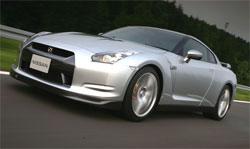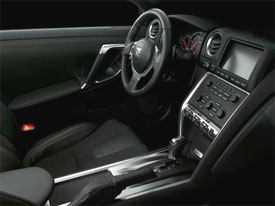2009 Nissan GT-R
When Nissan starting touting the merits of its new GT-R sports car, it sounded too good to be true. Super performance, mind bending technology, and priced more like a Corvette than a Ferrari. Numerous chances to see, learn, and touch the GT-R all built its case. Now with our expectations sky high, we’ve finally had a chance to spend real seat time in the GT-R. So let’s see if it’s worth the price of admission, or more.
The 2009 Nissan GT-R may be one of the biggest super car stories of the decade, but unlike many show stopping sports cars, this one actually lives up to its promotional hype. That’s because the GT-R is no newcomer to the high-performance ranks, but one with a pedigree built on that of the legendary Skyline GT-R.
First introduced in 1989, the Skyline GT-R established a fearsome reputation due to big turbo horsepower and all-wheel-drive traction. Its unobtainable position as a Japanese market-only model just added to its allure.
Finally available on our side of the Pacific, its replacement, dubbed simply GT-R, takes on the world’s best sports cars in both visual drama and full-tilt driving performance.
 The strikingly aggressive, if not aesthetically pleasing, body not only carries strong elements of the Skyline GT-R, but also displays hints of more familiar Nissan sporty endeavors like the 350Z and Infiniti G37.
The strikingly aggressive, if not aesthetically pleasing, body not only carries strong elements of the Skyline GT-R, but also displays hints of more familiar Nissan sporty endeavors like the 350Z and Infiniti G37.
Its front-engine PM, or Prime Midship, chassis includes a light and strong carbon-injected structure at the front, and composite aero panels on the underside.
It’s powered by an all-new GT-R exclusive 3.8-liter twin-turbo V6 rated at 480 horsepower and 430 pound-feet of torque. Yet for all its power, the turbo-six meets ultra-low-emission standards.
The engine’s ponies hit the ground through a 6-speed sequential dual-clutch transmission with paddle shifters, shift speed adjustment, and a full automatic mode - and the auto industry’s first independent rear transaxle all-wheel drive system that locates the transmission, transfer case, and final drive at the rear of the vehicle for optimum balance.
Its torque split automatically varies from 50/50, to 100-percent rear drive depending on speed, steering angle, tire slip and yaw rates.
A super lightweight double wishbone front and rear multi-link suspension with adjustable Bilstein Damptronic shocks, monstrous vented Brembo disc brakes, and GT-R-only 20-inch wheels wearing either nitrogen-filled summer run-flats, or optional all-season tires, complete the hardware.
With launch control engaged, the GT-R is capable of a 0-60 time of 3.5 seconds and a top speed of 193 miles-per-hour. Testing at Germany’s famed Nurburgring race track has delivered true super car lap times that rival those of Germany’s best.
Our fast laps came on the Reno-Fernley Raceway in Reno, Nevada. Punch the pedal and the GT-R surges off the line, with a huge power hit at 3,200 rpm.
But it’s the GT-R’s handling that’s most impressive. Driver-adjustable suspension modes range from tight to super-tight, and when combined with the all-wheel-drive system’s huge traction, help glue the GT-R to the track surface like few cars we’ve ever driven.
A touch of under steer on turn-in gives way to near perfect balance as you roll on the throttle at mid-corner. Never before has a 3,800 pound car felt like such a feather weight.
After that wild ride, our short street drive felt like a walk in the park. But it did show that even in the softest setting, the suspension is still pretty stiff and that the suspension shifts, while sharp as a tack at high speed, can be a little clunky in stop-and-go traffic.
 Like its exterior, the GT-R’s cockpit also favors business over fashion. With scads of buttons, readouts, and vents, it’s tailor-made for the driving enthusiast who demands total control.
Like its exterior, the GT-R’s cockpit also favors business over fashion. With scads of buttons, readouts, and vents, it’s tailor-made for the driving enthusiast who demands total control.
But, we were also impressed with the comfort of the body-hugging sport seats.
Still, the cabin’s centerpiece is a large multi-function screen that can display everything from rpm and steering angle, to info for the available navigation and Music Box Hard Drive.
As in so many sports cars, the rear seat is kid size only - lucky kids. The trunk capacity is a compact 8.8 cubic feet.
But you’re not paying $69,850 for the GT-R or $71,900 for the GT-R Premium, plus the inevitable dealer markup, just to get cargo space. You’re buying performance. Performance that rivals the most desired cars in the world, for a fraction of their cost.
And if you are one of the lucky 1,500 people who will garage a Nissan GT-R, rest assured, you are buying 2009’s primo super car experience and bargain.
Specifications
- Engine: 3.8-Liter Twin-turbo V6
- Horsepower: 480
- Torque: 430 Lb Feet
- 0-60 MPH: 3.5 Seconds






